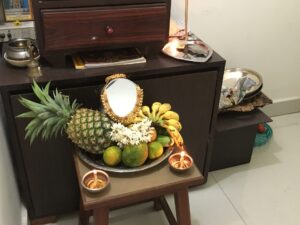
There are a lot of grand festivals that are celebrated in India, but it is a humble one that I treasure the most. It is not Diwali with its lights, gaiety, and splendor. It is not Holi with its splash of color and joy. It is not Ganesh Chaturthi with its pomp and processions. The festival I hold most dear to my heart is Ugadi or New Year.
Around the second week of April, every year, when the dawn breaks, our household would stir awake. My mother would whisper to us to get up. But unlike every day where we were required to open our eyes to the light, it would be dark that morning. My mother would remind us to not open our eyes and then would cover them with her hands, soft and warm from having just cooked a feast. We would walk thus through the living room and into the kitchen. We would sit cross-legged in a corner in front of the beautifully decorated deities. In addition to the flowers offered, on this day, there would be a plate placed in the center filled with rice, a variety of fruits and a mirror. The mirror would be arranged to face us and adorned with gold jewelry. Once we were seated directly in front of this mirror, my mother would slowly uncover our eyes. The first face we saw on the first day of the year would thus be our own. We would see our reflection surrounded by prosperity and wealth. We would pray for good fortune to favor us for the rest of the year. The observance of Ugadi thus becomes a powerful exercise in visualization.
Ugadi signifies the advent of spring and new beginnings. It is called Ugadi in Andhra Pradesh and Karnataka, Gudi Padwa in Maharashtra, Baisakhi in Punjab, Vishu in Kerala and Pahela Baisakh in Bengal. Songkran is celebrated in Thailand at around the same time and so is Aluth Avurudhu in Sri Lanka. We pray, are grateful and welcome the bounty of the harvest. The delicacies cooked that day – tender cashew payasa, bevu bella (neem and jaggery), holige (jaggery and lentil/coconut filled flatbreads), sesame seeds laddoos – are an homage to what the land has gifted us.
Now miles away from India, I have tried to uphold the tradition even if it’s not in the original pure format. My Ugadi is usually preceded by an urgent trip to the grocery store to get whatever fruits I can find. I rush to the Indian store before it closes and procure a brown coconut from there. I rummage through my kitchen cabinets and pull out the steel water jug that came with me on my first British Airlines flight to the US. I carefully mount the coconut on it. I fill rice on the best looking steel plate I have at the time and arrange it with fruits. Then I bring out a mirror that I got on a gift-card-inspired, impulsive trip to Bed Bath and Beyond, and lean it against the mirror. I pull out the jewelry I might have at home even if it is the cosmetic kind and adorn the mirror. The first face I see in the morning is my own – reflected in my vision of prosperity and good thoughts.
I celebrated Ugadi this as a child and then when I lived alone. I continued to observe it with my husband and then with my kids. I don’t know if it is the symbolism or meaningfulness or the family time that comes with the festival, but celebrating it is one of my greatest joys.
This time I will relive my childhood days as I celebrate it with my parents in India. Then 2 days later and 8000 miles away, when I am back in the Bay Area, I plan to celebrate it again with my husband and kids. Afterall there is only one thing better than celebrating Ugadi – it is getting to celebrate it twice.

Thanks, great article.